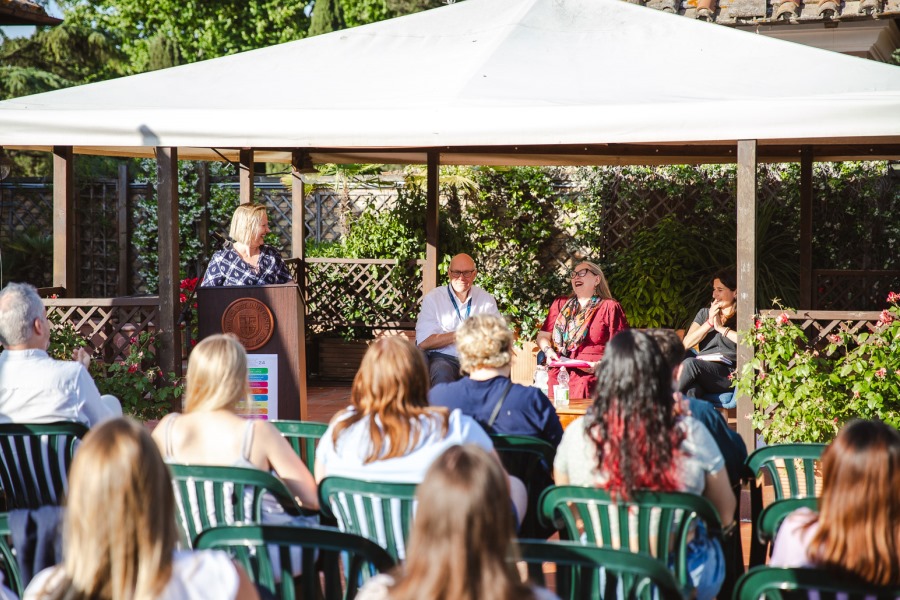Artificial Intelligence and Dyslexia: IFE Welcomes Vrailexia Representatives
The JCU Institute for Entrepreneurship organized an event called “Artificial Intelligence and Dyslexia” to present the Vrailexia project, on March 11, 2022. Vrailexia is a project that uses artificial intelligence and virtual reality to support higher education students with dyslexia. The speakers were Giuseppe Calabrò (Vrailexia team leader and Professor at the Università degli Studi della Tuscia), Silvia Fabbi (special education teacher), and Juri Taborri (biomedical engineer and researcher at the Università degli Studi della Tuscia). The talk was held in the context of Professor Ada Bertini‘s EXP Teaching Italian as a Second Language course.

Vrailexia
Dyslexia is a common learning difficulty that mainly affects reading, writing, and spelling. People with dyslexia have difficulties with taking notes, memorizing facts, and expressing themselves, which in turn may lead to low self-esteem, anxiety, and lack of motivation. According to Calabrò, a recent sociodemographic study shows that people with dyslexia born after 1999 are better equipped to deal with this disorder, because they were diagnosed very early on, and were provided with a support network and trained teachers. According to the same study, most students who were diagnosed with dyslexia around or after the age of 16, are more likely to abandon their studies.
Co-funded by the Erasmus+ Programme of the European Union, Vrailexia seeks to raise awareness in academia about special needs education and to ensure that dyslexic people are put in the condition to complete their higher education.
One of the tools that the project is developing is called “Into the Box,” a series of virtual reality tests for the assessment of dyslexia. Vrailexia is also working on the creation of an artificial intelligence platform called “Be Special,” which helps users by suggesting the most appropriate supporting methodologies for dyslexic students based on their specific issues. Another initiative that is underway is the creation of an online sharing repository that contains all digital modules, resources, tools, and other materials useful to facilitate the implementation of innovative teaching and learning methods to support both teachers and students.
Vrailexia is also working on the creation of a network of experts from various disciplines who are willing to share their knowledge and foster a student-centered approach by training teachers. Lastly, Vrailexia is building a network of Higher Education Institutions promoting a Memorandum of Understanding (MoU) for developing inclusion strategies for students with dyslexia to enhance their opportunity for success both during their academic career and subsequent integration into the labor market.
According to the results of over 2000 surveys, the most common things students with dyslexia have difficulties with are remaining focused, understanding texts, and memorizing things. The same survey also showed that the most effective digital support tools are audiobooks, mind maps, and the use of images. Lastly, the most effective support strategies include providing students with a tutor and dividing courses into modules.
The Università degli Studi della Tuscia, which is the coordinator of the Vrailexia project, has already adopted different measures to support its dyslexic students. They are provided with a specific orientation process, increased tutoring hours, and scanners that convert the font used in books into the dyslexia-friendly EasyReading font. Moreover, dyslexic students receive psychological support and are assigned a point person to help them navigate the university.
A very useful platform is “Reading Easy,” which provides users with many helpful tools. Users have the possibility to upload pictures of their handwritten notes, which will then be transcribed in a high legibility font. They are also given the option to select a word and find its definition and/or synonyms, to look up images that correspond to it, or even to upload their own image to associate with it. Users can also choose to have part of the text read out loud or turned into mind maps, to change the language, or highlight specific passages. As Calabrò explained, these tools are also helpful for students who aren’t affected by dyslexia. Researchers at Vrailexia are working on making an advanced version of Reading Easy called “Reasy,” which will be launched in May 2022.
Calabrò concluded the talk by explaining that one of the challenges that they are still facing is the fact that many people still don’t understand that dyslexia is an actual disability, which motivates them to keep raising awareness about this learning difficulty.





